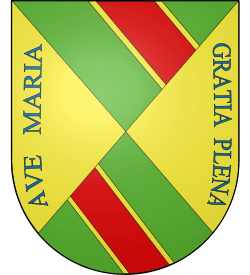Bernardino de Mendoza

- For the naval commander of the same name, see Bernardino de Mendoza (Captain General)
Bernardino de Mendoza (c. 1540 – 3 August 1604) was a Spanish military commander, a diplomat and a writer on military history and politics.
Bernardino de Mendoza was born in Guadalajara, Spain around 1540 as the son of Don Alonso Suarez de Mendoza, third Count of Coruña and Vicecount of Torija, and Doña Juana Jimenez de Cisneros. In 1560, he joined the army of Philip II and for more than fifteen years fought in the Low Countries under the command of Fernando Álvarez de Toledo, Duke of Alba. During this period, he participated in the Spanish military actions at (among others) Haarlem, Mookerheyde and Gembloux. In 1576, he was appointed a member of the military Order of St. James (Orden militar de Santiago) in recognition of these military achievements.
In 1578, Philip II sent Mendoza as his ambassador to London. There he acted not only as diplomat but also as spy, using a variety of secret codes in the reports he returned to Spain. He was expelled from England in 1584 after his involvement in Francis Throckmorton's plot against Elizabeth I was revealed. Crucial to this plot was his correspondence with Phillip II, using a code known only to himself and the king which they had learnt years earlier.
For the next six years, Bernardino de Mendoza served as Spanish ambassador to the king of France. As the effective agent of Philip's interventionist foreign policy, Mendoza acted in concert with the Catholic League, for which he acted as paymaster, funnelling to the Guise faction Habsburg funds, and which he encouraged to try, through popular riots, assassinations and military campaigns, to undercut any moderate Catholic party that offered a policy of rapprochement with the Huguenots, whom the militant Mendoza and his master considered as nothing more than heretics who needed to be crushed and rooted out like an infection.[1] His role in backing the ultra-Catholic house of Guise became so public that Henri III demanded his recall.
In 1591, with the Catholic League in disarray after the assassination of Henri, duc de Guise, he resigned due to ill health. His eyesight had been deteriorating for years and by the time of his return to Spain, he had become completely blind. His last years were spent in his house in Madrid.
Many of Mendoza's dispatches to Madrid were first deciphered only in the Simancas archives by De Lamar Jensen;[2] they revealed for the first time Mendoza's role in organizing and coordinating the Paris riots led by the duc de Guise, known as the Day of the Barricades (12 May 1588), presented as a spontaneous rising of the people and timed to coincide with the sailing of the Spanish Armada. Among Mendoza's public writings is a famous account of the war in the Low Countries entitled Comentario de lo sucecido en los Paises Bajos desde el año 1567 hasta el de 1577. Bernardino also published a book on the art of warfare under the title Theórica y práctica de la guerra and a Spanish translation of the Politicorum sive civilis doctrinae libri sex of the Flemish philosopher Justus Lipsius.
Notes
References
- Cortijo Ocaña, Antonio, & Á. Gómez Moreno. Bernardino de Mendoza. Comentario de lo sucecido en las Guerras de los Países Bajos. Madrid: Ministerio de Defensa, 2008.
- Miguel Cabañas Agrela (ed.), Bernardino de Mendoza, un escritor soldado al servicio de la monarquía católica (1540-1604), Diputación de Guadalajara: 2001.
- De Lamar Jensen. "Diplomacy and Dogmatism: Bernardino de Mendoza and the French Catholic League," Cambridge MA, Harvard University Press, 1964.
- For a translation into modern English of his Theórica y prática de guerra (Madrid: Pedro Madigal, 1595), Beatrice Heuser: The Strategy Makers: Thoughts on War and Society from Machiavelli to Clausewitz (Santa Monica, CA: Greenwood/Praeger, 2010), pp. 87–102.
External links
- (Spanish) Biography of Bernardino de Mendoza by Prof. Dr. Antonio Herrera Casado.